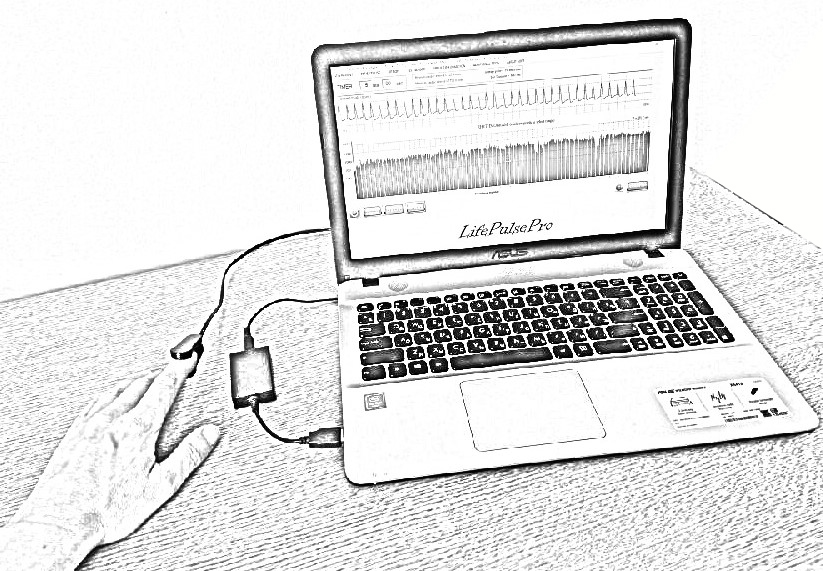Unlike the standard pulse variability test, which uses electrocardiography methods and electrical contacts, the LifePulsePro system presents a new approach by using a photometric pulse sensor. This sensor captures and records the complex details of the actual pulse wave directly from the location of the peripheral pulse, shifting the focus from the pulses of electrical excitation of the heart. Consequently, the system captures pulse waves that propagate after the electrical impulses of the heart, correlating with the flow of blood into the cardiovascular system of the body. This innovative methodology conforms to the principles of Oriental medicine, being more closely aligned with holistic views on health.
The use of a photometric pulse sensor in the LifePulsePro system makes it possible to effectively apply the mathematical basis developed for assessing heart rate variability, originally intended for electrocardiomonitoring. This integration makes it possible to better understand the dynamic changes in the amplitude of the pulse wave, providing a detailed understanding of the state of the body and the influence of both internal and external factors.
Comprehensive analysis and processing of the pulse registration results in the LifePulsePro system are carried out in accordance with established methodologies and using standard mathematical tools synonymous with the assessment of heart rate variability. The system takes into account various factors, including the gender and age of the patient, when carefully analyzing and interpreting the results.
Heart rate variability (HRV) plays a key role as a non-invasive tool for assessing the overall state of the cardiovascular system. This provides valuable information about the balance between sympathetic and parasympathetic activities of the autonomic nervous system. This balance profoundly affects heart rate regulation and cardiovascular function, making HRV a powerful indicator of overall well-being.
Extensive studies emphasize the importance of HRV as a prognostic factor of cardiovascular diseases, covering conditions such as hypertension, myocardial infarction (heart attack), congestive heart failure and arrhythmias. Moreover, a decrease in HRV becomes an alarming predictor of an increased risk of mortality in patients with pre-existing heart diseases.
Regular HRV monitoring is a way to clinically understand a person's condition. By carefully analyzing HRV indicators, practitioners receive information about the patient's physiological reactions to stress, physical exertion, medications and various interventions. These data make it possible to make informed treatment decisions and facilitate the evaluation of the effectiveness of therapeutic interventions.
HRV optimization plays a primary role in the integrated management of cardiovascular health. Individual lifestyle changes, including regular physical activity, stress reduction techniques (including meditation and deep breathing exercises) and a balanced diet, have a transformative effect on HRV. In addition, targeted medications and interventions aimed at modulating the autonomic nervous system are potential allies in restoring and strengthening HRV.
Summing up, we can say that heart rate variability goes beyond a simple indicator; it turns into a valuable marker for a comprehensive assessment of the state of the cardiovascular system. The LifePulsePro system, thanks to an innovative photometric pulse sensor, expands the possibilities of HRV assessment, reflecting the complex interaction of the dynamics of the autonomic nervous system and the control mechanisms of the cardiovascular system. HRV monitoring makes it possible to identify people at risk, direct therapeutic efforts and, ultimately, contribute to improving the state of the cardiovascular system. In addition, the LifePulsePro system makes it possible to obtain a dynamic view of the patient's lifestyle and physiological reactions over time. This longitudinal perspective is valuable for understanding how various lifestyle factors, interventions and external influences affect the cardiovascular system.
Since the system tracks fluctuations in heart rate variability, it reveals a complex relationship between the patient's daily routine, stress factors, physical activity and general well-being. This comprehensive understanding allows practitioners to provide personalized, evidence-based recommendations, contributing to a positive lifestyle change that can significantly improve cardiovascular health.
LifePulsePro's real-time monitoring capabilities create a dynamic feedback loop that allows both healthcare providers and patients to observe the impact of changes and interventions in real life. Whether it is adjusting the exercise regime, improving stress management methods, optimizing the medication regimen or adjusting dietary habits, LifePulsePro's continuous analytics contributes to informed decision-making and consistent improvements.
In fact, the LifePulse Pro system goes beyond traditional diagnostic approaches, turning into a personalized healthcare assistant. The diagnostic system accompanies patients on their way to improving the state of the cardiovascular system, offering recommendations based on real-time data and scientific rigor. The integration of continuous monitoring into LifePulsePro expands the paradigm of cardiovascular care, when personalized recommendations are based not only on a single assessment, but also on a changing description of the patient's health and lifestyle.

